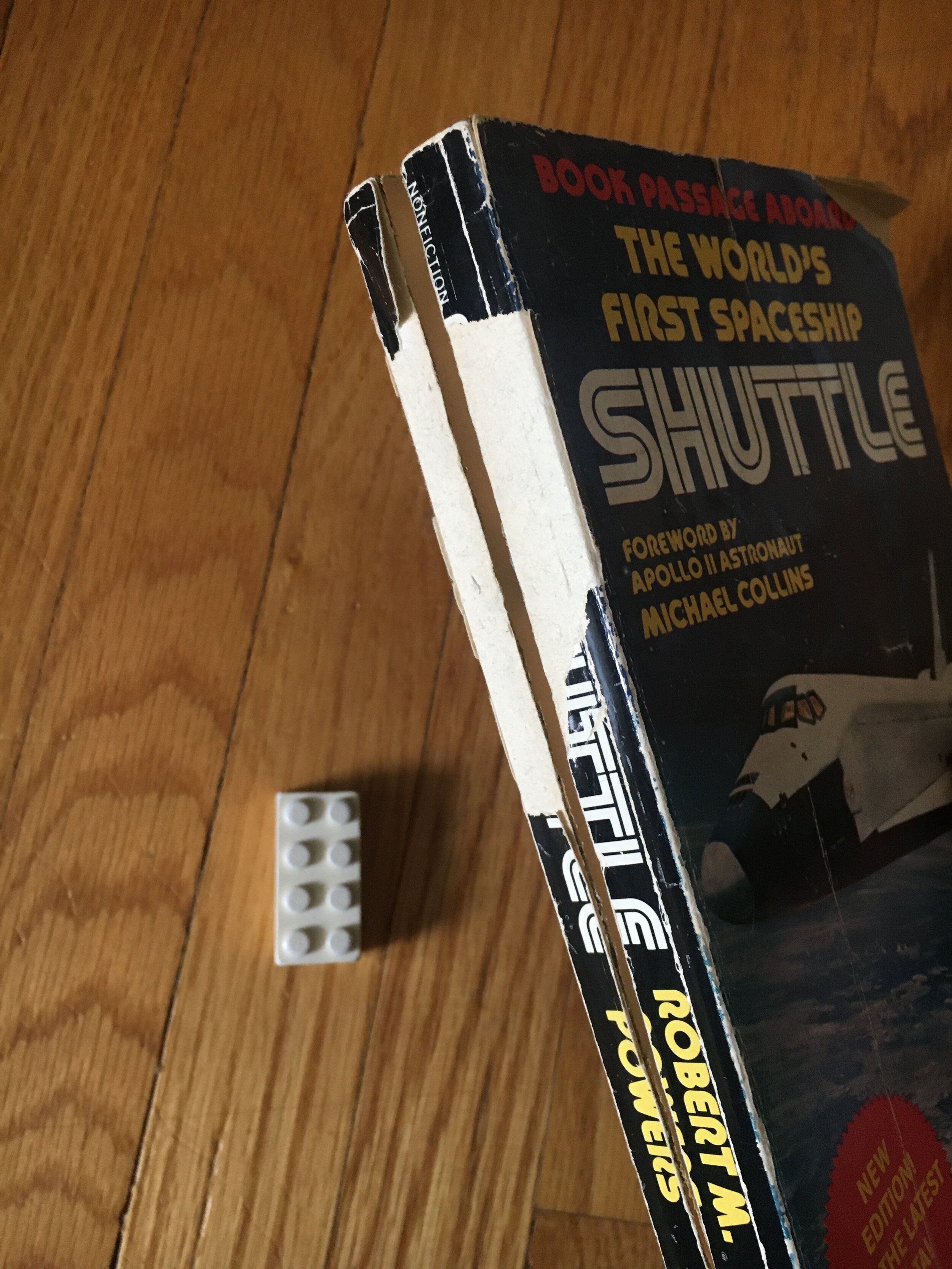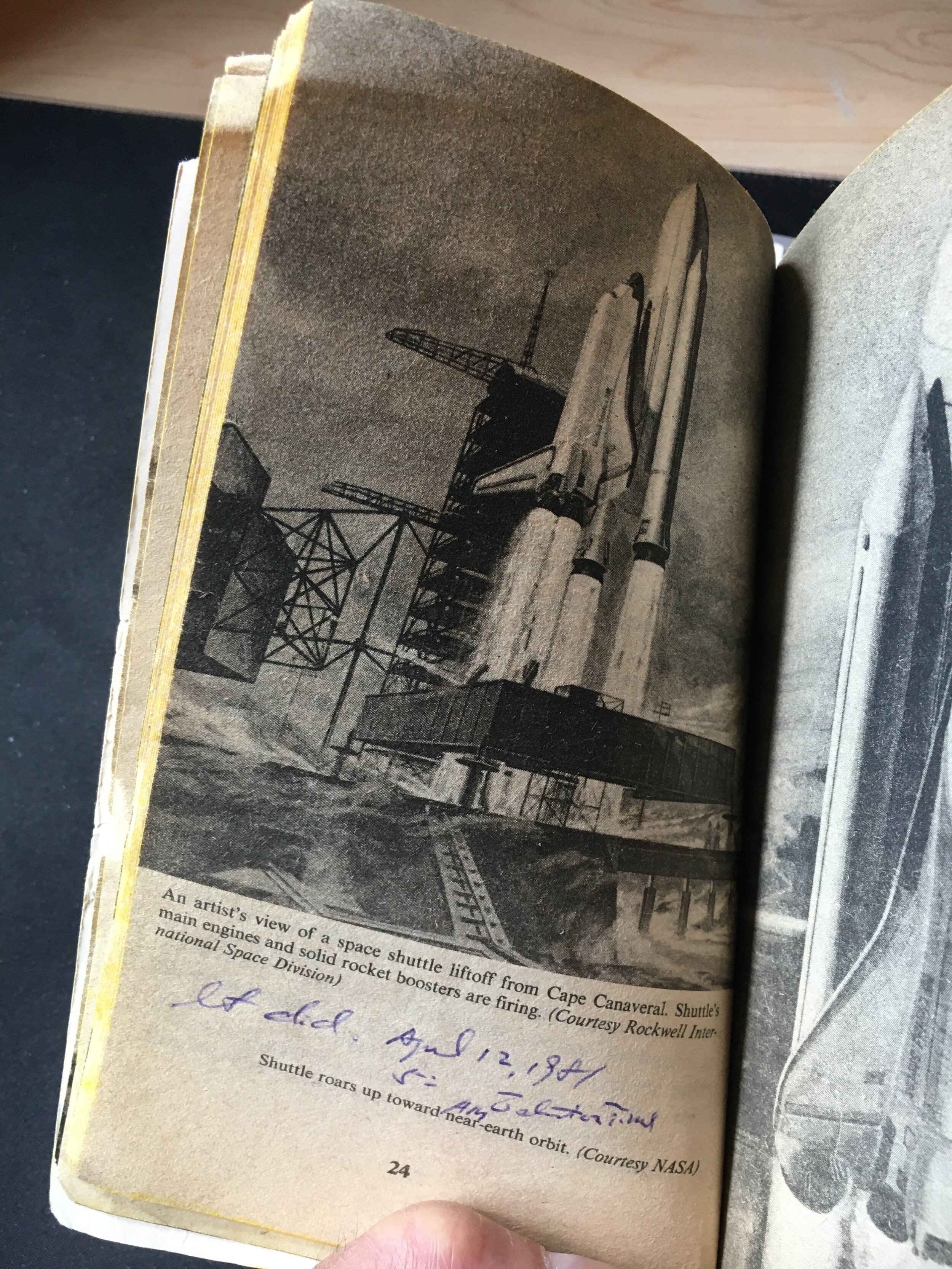Shuttle: The World’s First Spaceship
I’ve had people critique my love of print books as “just nostalgia.” Setting aside for the moment all the eminently valid archival, psychological, and scientific reasons why print still holds a prime place in literary culture, what exactly is wrong with nostalgia as yet another reason for keeping print books around?
To wit, my copy of Shuttle: The World’s First Spaceship by Robert M. Powers, the Warner Books edition published May 1980 by arrangement with Stackpole Books, eleven months before the maiden flight of the Space Shuttle Columbia on Mission STS-1, April 12, 1981.
Shuttle: The World’s First Spaceship by Robert M. Powers, published in May 1980 by Warner Books. Note that it is a NEW EDITION! ALL THE LATEST DATA!
In large part because of the influence of my father, I’ve been a fan of aviation and space exploration my whole life. This book was actually one of his acquisitions, but one that I quickly adopted as my own. I may have missed the era of the moon missions, but I was living the age of reusable spacecraft and had no intention of missing a thing! Shuttle became one of my most prized possessions as a result. It served as my primary source for a science project and oversized display back in elementary school. I would reference it for specs when watching launches and landings. Seeing it triggers memories of exactly where I was when I heard about the Challenger disaster of 1986.
As old as the shuttles themselves, my copy of Shuttle has lived a hard but well-loved and well-used life.
The split and damaged spine of this particular Shuttle.
The split happens to land on the spread discussing an as-yet-unnamed 2.4 m Space Telescope planned to be carried into space in the Space Shuttle cargo bay. See more about the Hubble Space Telescope below.
When I finally had a chance to see one of the shuttles in real life – the Space Shuttle Endeavour at the California Science Center – yeah, I brought my copy of Shuttle along so that I could get a picture of me, it, and the real thing.
Our Head Alien, poster boy for nerd tourism, at the California Science Center with the Space Shuttle Endeavour and his copy of Shuttle: The World’s First Spaceship. There is, in fact, a partial ebook version available at Google Books. But the photo op would not have turned out quite as well. Delightfully, there is also a new print edition available, released September 15, 2017, as part of the Stackpole Classics series (we’ve included a link at the end of this post to look it up at your local Canadian indie bookstore).
Two more recent but equally nostalgic reasons for featuring this book. Actually, three…
One, in part to celebrate the 40th anniversary of the first Shuttle launch, LEGO released its new NASA Space Shuttle Discovery model, Set 10283, part of their new Adults Welcome line and marketing push. The model includes the now-named Hubble Space Telescope, launched and placed in orbit as part of Mission STS-31 in April 1990. Building the LEGO set had me pulling out the book again to compare diagrams, facts, and figures, another tangible way to mark… and sense… the passage of 40 years. (Plus it’s possible LEGO makes up a reasonably high percentage of the “Book Adjacent” content on some of the shelves here at the Butterflies & Aliens Library…)
Two, the foreword for Shuttle was written by Apollo 11 astronaut Michael Collins, who died this past Wednesday, April 28, 2021. As the Command Module Pilot, Collins stayed in lunar orbit while fellow astronauts Neil Armstrong and Edwin "Buzz" Aldrin walked on the moon, just eleven years before Shuttle was published. Forty years on, as much of our modern day space exploration enters an era of increasing commercialization, it’s worth looking back at the path we’ve travelled, just as Shuttle had Collins connect its readers back to Apollo. Rest in peace, space traveller.
Three, while writing this post, I happened across one of those things that only happens in print books, a bit of marginalia, this one from my father. On page 24, the caption below the illustration reads “An artist’s view of a space shuttle liftoff from Cape Canaveral. Shuttle’s main engines and solid rocket boosters are firing.” A second caption reads “Shuttle roars up towards near-earth orbit.”
Between the two, in my father’s distinct cursive, he wrote the following:
It did. April 12, 1981
5 AM Alberta time.
Happy reminiscing.
– Winston
Marginalia in our Chief Alien’s copy of Shuttle.








